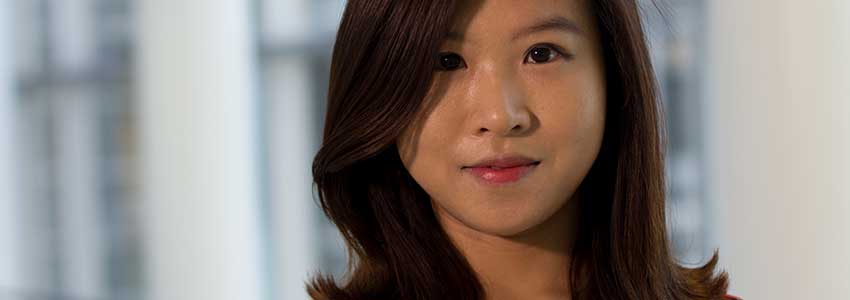Before coming to Michigan, Jihyeon worked at the Argonne National Lab in Chicago, but she knew she shouldn’t stay put. “It was while working at Argonne that I realized to do more important or precious research, I need to know more about whatever field I’m in.” She applied to six graduate schools and was drawn to U-M because of her faculty advisor, Professor Nicholas Kotov. “He is famous in my field and set me up as Graduate Student Research Assistant. So I packed all my stuff in my tiny car and moved to Michigan from Chicago.”
Jihyeon’s research with inorganic nanoparticles in chiral shapes is doing groundbreaking work. She explains, “Chiral shapes, which determine whether you are left or right handed, are all over. In the human body, they are in the sugars of our DNA and RNA, where they present as left handed. The pharmaceutical applications related to chirality are very important.” Many people remember the prevalence of birth defects caused by thalidomide in a morning sickness drug that was developed in the wrong-handed shape. Today, chiral molecular drugs comprise over a third of worldwide drug sales, making the application of chiral synthesis critical for diagnosis and therapy in the pharmaceutical industry.
Researchers have been studied by inorganic scientists for decades. Jihyeon says, “There isn’t much inorganic research on chirality, so we are a rising star in our field doing this research.” One of the goals of studying chirality of inorganic nanostructures is to discover the origin of homochirality in natural compounds. She explains, “If you look at a plant winding on a tree or the swirl of a shell, you’ll notice they are right handed. Nature using chirality as very important factor, but we really don’t know why. Circular particles are primary interactions at the cellular level, but there were no experiments to show the effect of geometric nanostructures.” That’s where Jihyeon’s lab came in.
“Our study was the first of its kind. We eliminated right/left characteristics to view them separately in water, but when illuminated by exposure right or left light they would reassemble their heliocore structure,” she says. The recipient of many awards, Jihyeon’s work on chiral semiconducting nanoparticles has been very well received and was published last year in Nature Materials, showing that the geometry of nanostructures can be imprinted by circular exposure.
The next steps of her research could have significant implications for the nanostructures of the primary space building material, dark matter. “Dark matter has strong magnetic dipole properties that allow us to study the nanostructure and further our original research on chirality.”
U-M is a great fit for Jihyeon. “I love it here. The foundation for research is amazing. If I want to analyze a sample with instruments, we have everything I could need. We have so many talented professors to work with. My advisor is well connected, and he can guide me to resources all over campus. That base is very nice.”
A fifth year student, Jihyeon will soon start writing her dissertation. With great funding in hand, she has the luxury to advance her research and stay for a sixth year. She has strong support for that strategy:
“One thing my advisor does is keep students at least for six years. I think that is good because we need to keep growing our knowledge and building potential before going out to the real world and starting our careers.” Jihyeon wants to be a professor, so as a first step toward that goal, she’ll seek a postdoctoral position after graduation.
She’s traveled extensively during the last few years when attending conferences in her field. Fortunately, they have been in exciting places like San Diego and Florence, Italy. Jihyeon spends extra time taking it all in: “It was my first time in Florence, and during the whole flight I read a thick book about art, the history of Florence, and the masters like Leonardo Da Vinci. I was so excited when I landed. It was so fun – the food was great, I saw the ‘Mona Lisa,’ I just loved it.”
Jihyeon makes time for fun, trying to strike that challenging work/life balance. She comments, “I love Ann Arbor as a student especially. I’m playing tennis, and even though Ann Arbor has a long winter, U-M has very nice indoor tennis facilities. Summer is great; there are many activities we can do. I’m outdoorsy, and there is good kayaking and hiking, and the tennis outdoors is free. I just took up golf. It is a very healthy life.” A relatively new tennis player, she’s hooked on the sport. “I started playing tennis three years ago, and I was the president of tennis club last year. I organized games for 30 people to play every Friday night. After that, we’d go grab a beer,” she laughs, acknowledging that grad students definitely need to have an outlet or two.

